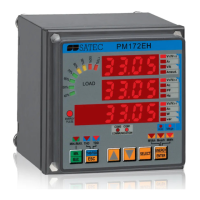58 Chapter 5 Data Display
5
Per phase power and power factor readings are displayed only in 4LN3/4LL3
and 3LN3/3LL3 wiring modes (see Section 4.1) if the phase power display is
enabled in the Display Setup menu (see Section 4.11).
6
Phase energy readings are displayed only in 4LN3/4LL3 and 3LN3/3LL3
wiring modes (see Section 4.1) if they are enabled in the User Selectable Options
menu (see Section 4.12).
7
When the 4LN3 or 3LN3 wiring mode is selected, the voltages will be line-to-
neutral; for any other wiring mode, they will be line-to-line voltages.
8
Displayed only in the 4LN3 or 3LN3 wiring mode.
9
TOU energy readings are displayed in MWh/Mvarh/MVAh according to the
energy input assigned to the register. A corresponding arrow LED will be lit
showing energy units when a register reading is displayed. If a TOU register counts
external pulses, the MWh LED will be lit.
10
Harmonic power and energy readings are displayed only if they are enabled in
the User Selectable Options menu (see Section 4.12).
5.3 Self-Test Diagnostics Display
The PM172EH periodically performs self-test diagnostics during
operation. If the instrument fails the test, it discards the last measurement
results, and an error code is displayed for one second on all LEDs. Error
codes are listed in Table 5-2. Frequent failures may be the result of
excessive electrical noise in the region of the instrument. If the instrument
resets itself continuously, contact your local distributor.
Table 5-2 Self-Test Diagnostic Codes
Code Meaning Code Meaning
1 ROM error 5 Out of control trap
2 RAM error 7 Timing failure
3 Watch dog timer reset 8 Normal power up
4 Sampling failure 9 External reset (warm restart)
NOTE
The PM172EH provides a self-check alarm register accessible through
communications that indicates possible problems with instrument hardware or
setup configuration. The hardware problems are indicated by the appropriate bits,
which are set whenever the instrument fails self-test diagnostics, or in the event of
loss of power. The setup configuration problems are indicated by the dedicated bit
which is set when either configuration register is corrupted. In this event, your
instrument will use the default configuration. For more information on the self-
check alarm register, refer to the communications reference guides shipped with
your instrument.

